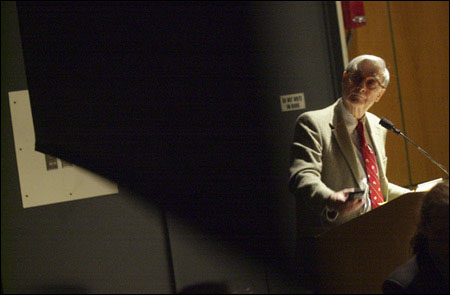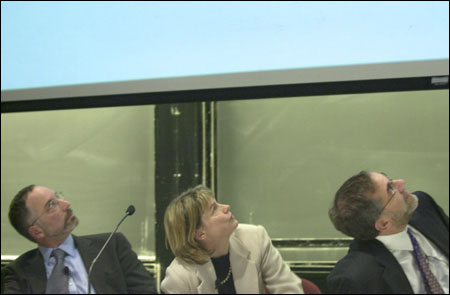Environment panel not all gloom
Symposium reports Earth in dire straits

The ivory-billed woodpecker could be the poster child for the world’s dwindling biodiversity: Found across the South in the 1800s, its American habitat shrank steadily to a single tract in Louisiana and eventually one last individual, a female killed when her nest was blown apart in a 1944 storm. Small numbers of the birds hobbled on in Cuba, although none has been seen there since 1987.
“The destruction, ongoing, of the environment in which these marvelous, marvelous three and a half billion years of evolution exist is accelerating due to human action,” Harvard biologist E.O. Wilson said last Friday, citing the woodpecker’s fate at a Harvard Museum of Natural History (HMNH) symposium on changing natural habitats and vanishing species. “We can reverse the trend or at least bring it to a halt, slow it down very substantially, if we use our immense resources and common sense, and if we use science productively.”
Wilson went on to call for a deploying of global resources to the tune of $28 billion to protect the Earth’s rich biodiversity from the human scourges of habitat destruction, climate change, invasive species, pollution, overpopulation, and overharvesting.
Daunting as that figure might seem, the two-time Pulitzer-winner and founder of the modern study of biodiversity described the proposed expenditure as “the best deal ever offered humanity,” noting that the sum represents just 0.1 percent of the world’s annual economic output. Such an investment, Wilson said, could rescue 25 biodiversity “hot spots” that cover only 1.4 percent of the Earth’s surface yet are home to some 40 percent of known plant and animal species.

“If we can save that 1.4 percent, we will have taken a giant leap forward,” said Wilson, the Pellegrino University Research Professor Emeritus.
Wilson was joined on last week’s HMNH panel by oceanographer Jeremy Jackson of the Scripps Institute of Oceanography and Smithsonian Tropical Research Institute and a quartet of Harvard scientists. Using statistics and anecdotes, the panelists painted a gloomy picture of mankind’s stewardship of the world’s species: Humans burn an estimated 5 percent of the Earth’s surface every year. Pollutants have so sullied the Arctic that Inuit mothers’ breast milk is toxic to their offspring and themselves. The ocean floor ruined by trawling outstrips all of the forests ever cut in the history of humanity. Two panelists reported reaching the dispiriting realization, decades into their academic careers, that many or most of the species and ecosystems they had studied no longer existed.
The scientists portrayed the loss of countless species as doubly troubling because many of these species will pass from existence without having ever been known to humans. “We are living on an unexplored planet,” Wilson said, noting that while 1.7 million species are known to exist today, the actual number in existence could range as high as 10 million or even 100 million.
Missy Holbrook, professor of biology and Charles Bullard Professor of Forestry, likened these silent losses to a sudden vanishing of books from nearby Widener Library: “Imagine if the books just suddenly started disappearing – one here, one there, sometimes a whole shelf-full, maybe a whole room or collection. Now if this library were imperfectly cataloged, you might not notice it right away … and yet the entire fabric of our cultural history and our ability to learn new things would be tremendously diminished by the loss of this legacy.”
Oceanographer Jackson described the world’s marine environment, largely “out of sight and out of mind,” as especially hard-hit. Huge swaths of the seas are now all but devoid of life, with estuaries the world over overrun by microbes and jellyfish – a phenomenon Jackson dubs “the rise of slime.”
“It’s a virtual reality trip back half a billion years,” Jackson said of the re-emergence of bacteria and jellyfish as dominant aquatic species. “We are reversing half a billion years of evolution in the ocean, and we’ve done it in a century.”
In addition to “the rise of slime,” Jackson identified other pressing marine concerns as overfishing; the destruction of continental shelves; the proliferation of invasive species; ocean warming; and the poisoning of food webs through pollution. Even the best-protected areas of the world’s oceans have been despoiled, Jackson said, and the results have been devastating to ocean-dwelling carnivores and herbivores of all sizes, not to mention coral reefs.
“The good news is that the best-protected coral reef in the world, the Great Barrier Reef, is only a third of the way to ecological extinction,” said Jackson, the William and Mary B. Ritter Professor of Oceanography at the Scripps Institute of Oceanography and senior scientist at the Smithsonian Tropical Research Institute in Panama. “The bad news is that the best-protected coral reef in the world is a third of the way to ecological extinction.”
Depressing as this all sounds, several panelists voiced the opinion that things will likely have to get significantly worse before they start to get better. “I think we overcome denial when it really hurts,” Jackson said.
“We will periodically experience environmental 9/11s,” added Peter S. Ashton, the Charles Bullard Research Professor of Forestry – increasingly severe environmental and climate catastrophes that may finally serve to galvanize the developed world.
Ashton said global trade has a role to play in safeguarding biodiversity hot spots. Citing the experiences of such developing nations as Costa Rica and Malaysia, where the rise of an urban middle class has mitigated environmental pressures in outlying areas, he suggests global trade as a tool to reduce habitat destruction in other poor countries.
Wilson agreed that the Bush administration “can find a very good out by linking the environment … to current stated concerns about security.” By working to lift citizens of the developing world out of poverty, he said, the United States could simultaneously reduce pressures on biodiversity while raising living standards for impoverished individuals who might otherwise direct their anger at the United States.
Mankind’s choice could come down to either finding ways to make biodiversity and environmental protection worth people’s while or, as moderator Provost Steven E. Hyman quipped at the conclusion of the symposium, finding “great recipes for jellyfish with an E. coli sauce.”




